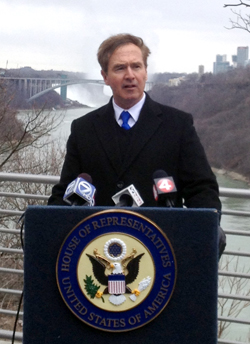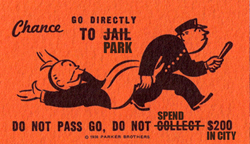Will Higgins Help the City or the State Park With his New Plan?
By Frank Parato
A press release from Congressman Brian Higgins (NY-26) entitled “Higgins Kicks Off Effort to Help Niagara Falls Reclaim its Waterfront,” gives the Niagara Falls Reporter a glimmer of hope.
A glimmer is not a lot.
The sub headline of the release reads: “Congressman Says Removal of Robert Moses Parkway is NYPA's Responsibility.”
Higgins assumed representation of the City of Niagara Falls three weeks ago, taking over the role that Louise Slaughter had for the past 10 years. And Higgins, who seems to want to veer away from Slaughter’s policy of benign neglect, claims to want to help the city overcome the damage created by the Robert Moses Parkway in order “to help the City fight to reclaim its waterfront and reap the economic benefit.”
His plan entitled "The Niagara Falls Waterfront: NYPA's Responsibility for the Robert Moses Parkway" describes how the state stole the wealth of Niagara Falls.
“The transfer of wealth from Niagara Falls, N.Y., which is beset with a staggering concentration of poverty and blight to the New York City area - the world’s financial capital - is inequitable and unconscionable,” Higgins’ report said.
His announcement of his plan came days after the Reporter revealed what is expected to be the result of the New York State Parks’ “Riverway” plan for the south segment of the Robert Moses Parkway. The plan is said to help the city and foster tourism, but will it further serve to transfer the wealth out of Niagara Falls by the state’s continued use of the Robert Moses Parkway to divert travelers headed to the Niagara Falls State Park away from the city.
The Niagara Falls State Parks operations resemble big business more than a traditional state park and it is in competition with businesses in the city. At the same time, there is also a conflict of interest, because it is acting as the lead governing agency for the (re)design of state roadways leading into the park through the city.
For years, the Reporter has criticized both State Parks and the New York Power Authority (NYPA) -- a quasi-governmental, Albany-controlled, "public benefit" corporation, now in the sixth year of a second 50-year license to control the hydroelectric energy of the Niagara. These are the twin monsters who steal the wealth of this region and send it to New York City.
Higgins may be the region’s best hope, among government officials, for restoring the Falls back to power and prosperity.
He understands the damage the Parkway has done.
"NYPA planned the Parkway, NYPA built it, NYPA evicted several scores of homeowners and other property owners to seize the land on which it sits, and NYPA owns the land under the Parkway to this day," Higgins wrote in a letter to NYPA Chairman John Koelmel.
Built in the early 1960s, as the brainchild of Robert Moses, who served as NYPA chairman at that time, the Niagara Parkway (renamed the Robert Moses Parkway) stretches over 18 miles, separating the City from its waterfront.
Moses almost singlehandedly arranged for the transfer of wealth out of this region, making Niagara Falls Albany’s ATM machine. He made the original deal to turn local control of our hydropower over to Albany, then created the parkway that was the means for the State Park to hijack our tourists, in contravention to Frederick Law Olmsted’s original park design, which was to have a commercial-free, all-natural park.
State Parks have revealed their not-so-hidden agenda in documents describing their Riverway plan, which is not, of course, removing the parkway.
“One of the major concerns is that (removing the parkway) does not provide direct access to the State Park from the U.S. interstate system, which is how the majority of park visitors get to the park,” a state park report says.
Despite its tremendous assets, the city suffers from staggering poverty and blight and, while almost every other region gets to take advantage of its natural assets, Niagara Falls does not.
Higgins says that he understands that the Robert Moses Parkway is a physical barrier and an economic barrier to the renaissance of Niagara Falls. He may not fully understand that the State Parks’ preferred “Riverway” plan does not advocate removal of the Robert Moses Parkway south section.
This is where the Robert Moses Parkway does its main damage: It serves as the direct link from the U.S. interstate to the Niagara Falls State Park without tourists having to go through the city, where they might shop, dine, and pay to park in front of local businesses.
Higgins states that only $5 million in federal funding, authorized by the Greater Buffalo-Niagara Regional Transportation Council, is available for the south segment project of NYPA. He wants NYPA to fund the rest. The unintended consequence of Higgins’ plan might be that NYPA will come up with additional money to fund the State’s plan and have the opposite effect of what Higgins says he wants for the city. The State will get the money from NYPA to “improve” but not remove the Robert Moses Parkway - “improve” being defined as making the parkway serve the role of getting more tourists into the State Park first.
The park has 1,300 paid parking spaces, five paid attractions, three restaurants, wedding and banquet businesses, four large souvenir stores and numerous concession stands. It is essential for the business interests of the park to get the tourists first, since the bulk of its parking, restaurant, and souvenir business depends on captive tourists, especially since their prices are far higher than city businesses that offer the same products.
Higgins is asking NYPA for approximately $120 million to fund both sections of the parkway’s so–called removal – which, again, is not a removal. If accomplished, it will strengthen the parks ability to depress local businesses.
Our best hope is that NYPA does not come up with the money, unless the Robert Moses parkway is removed altogether.

